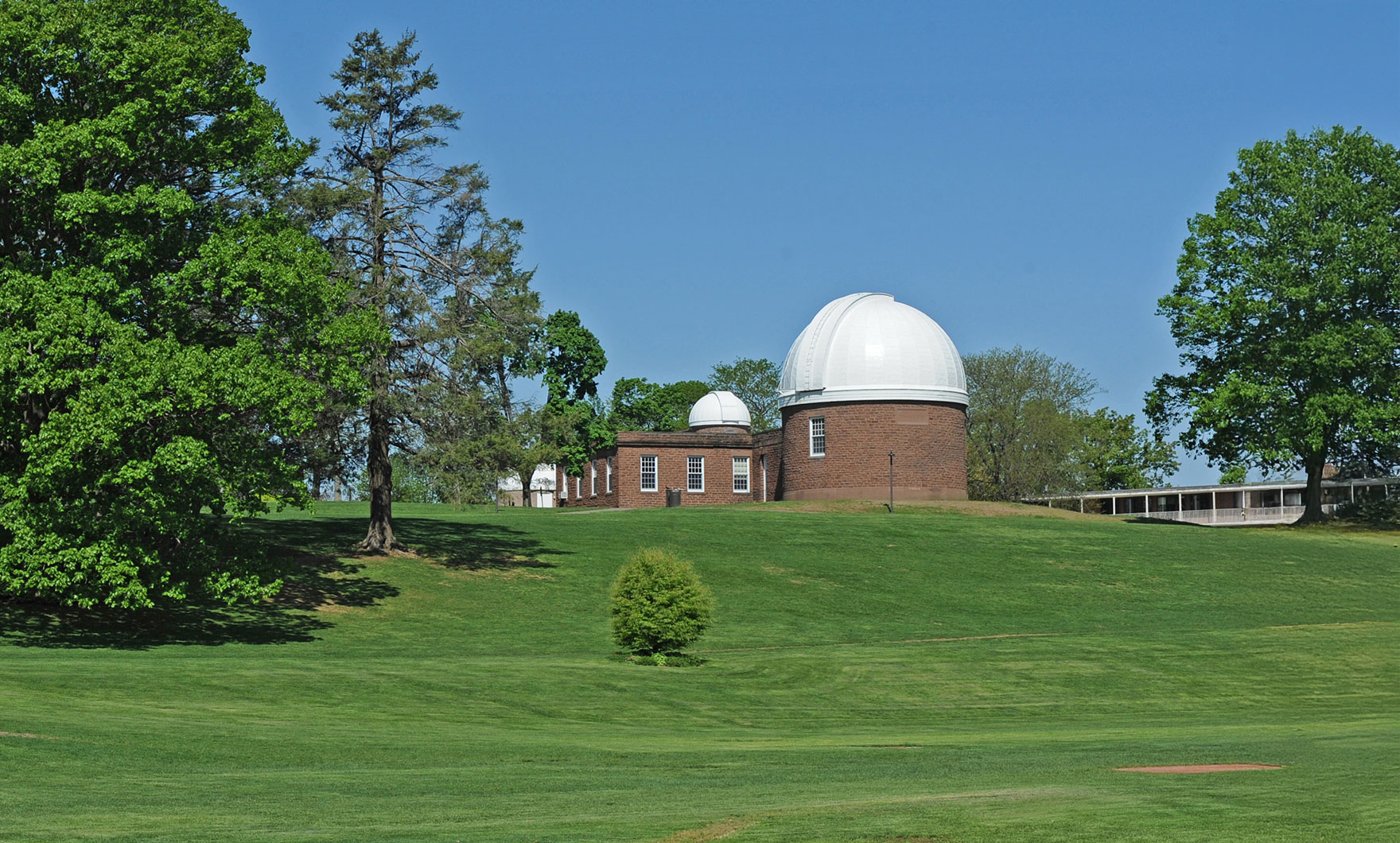

Van Vleck Observatory
Observatory at a Glance
-
1916 Year established
-
Dozens of annual public events
-
100s of engaged visitors in outreach programs each year
Observatory Features
The observatory features world-class resources for students, faculty, and visitors alike. Students use the telescopes for coursework and research, gaining experience in data collection, analysis, and instrument operation, and developing essential skills for future academic and professional pursuits.
Research Library and History Museum
Browse thousands of historic monographs, catalogs, charts, magazines, Under Connecticut Skies exhibition, and more.
Portable Planetarium
Our Digitalis and STARLAB portable planetariums provide immersive teaching tools for classes and educational programs.
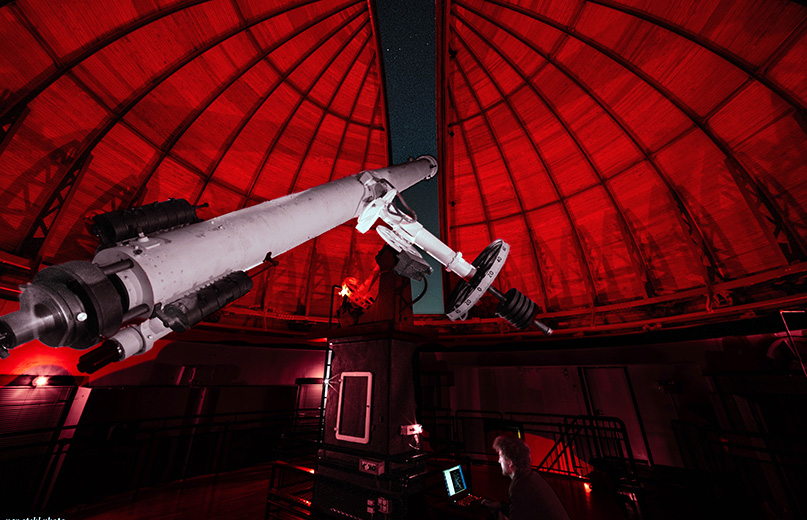
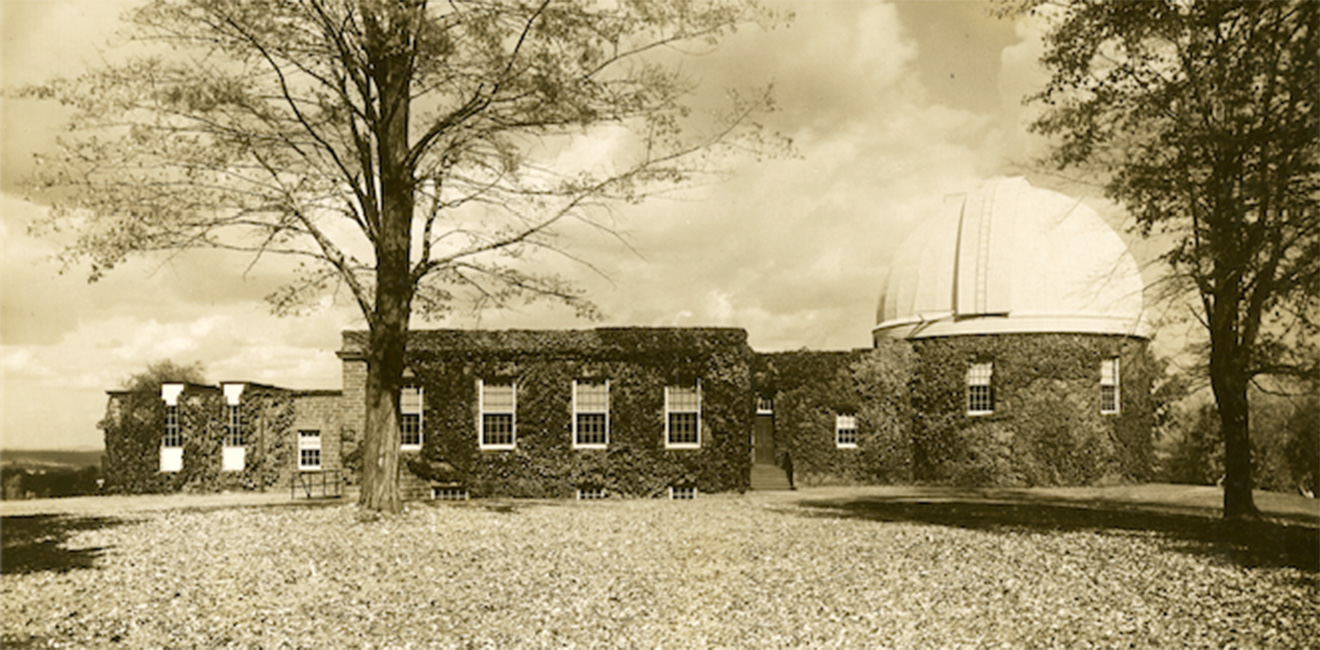
Van Vleck Observatory, 1930s
Joseph Van Vleck gave $25,000 to fund the new Van Vleck Observatory in 1903. After good investments and more Van Vleck family gifts, ground broke in 1914.
Our History
A defining Astronomy Department feature, the observatory blends historical significance with modern research. Prof. Augustus Smith taught Wesleyan's first astronomy course and led the Department of Mathematics and Astronomy in 1843. The observatory was named for his successor, Prof. John Van Vleck.
When it was founded in 1831, Wesleyan University listed astronomy as a course given by Prof. Augustus W. Smith, M.A., Professor of Mathematics, who later became President of the University (1852-1857). In 1843, Prof. Smith headed the newly formed Department of Mathematics and Astronomy. He was succeeded by Prof. John M. Van Vleck, M.A.
As early as 1832, the Prudential Committee (Trustees) considered construction of an observatory on South College, then called the Lyceum Building. The venture was deferred, probably for lack of funds. Several letters to President Fisk in these early years show his interest in astronomy and are on file in Olin Library. One dated August 14, 1833 from Elysha Burritt of New Britain, Connecticut, refers to a "class book for the study of astronomy" in preparation. Another dated November 18, 1834 from E. P. Tracy of Salem, Connecticut, diagrams a proposed modification to the Newtonian reflector using an "achromatic prismatic lens" instead of a diagonal flat mirror.
In 1835, President and Mrs. Fisk, accompanied by Harvey B. Lane (Class of 1835), went to Europe for a year partly for the purpose of purchasing a telescope and other scientific equipment for Wesleyan. President Fisk discussed telescopes with George Biddell Airy at the Royal Greenwich Observatory. A letter to Augustus Smith told of a visit to Houghton and Simms in London, where he saw a, "beautiful instrument just finished for India," which, "Mr. Simms thinks would be all you would want for astronomical purposes." It was so costly (£150) that plans for other instruments (a heliostat and transit) would have to be dropped if Fisk bought it.

Finally, in April 1836, President Fisk and Mr. Lane obtained the 6-inch refractor from M. Lerebours, telescope maker in Paris. M. Arago, Director of the Paris Observatory, M. Arago tested it. On May 2, 1836, Fisk paid 6,000 French francs for the telescope and 960 francs to ship it to Middletown. Arago, who provided a "certificate" of his approval (on file in Olin Library), also advised Lane to purchase a magnetic compass since "accurate magnetic observations in the United States are more needed than any other."
In a letter dated June 5, 1836, Augustus Smith expressed his delight at the purchase of the telescope and said that the "magnetic instrument will be very desirable." On August 15, he wrote, "The telescope arrived about the middle of July and I think it equal to that at New Haven. The focal distance is less and the aperture greater."
It was one of the first astronomical telescopes in New England, and had a visual doublet of 6 inches aperture and focal length 7 feet in a brass tube mounted equatorially on a teak wood stand. Other early refractors in the United States included:
- 1828 Yale University, New Haven, Connecticut: a 5-inch
- 1840 Harvard College, Cambridge, Massachusetts: the Dana 2 3/4-inch and Shortt 4-inch
- 1845 Cincinnati, Ohio: a 12-inch
- 1846 Harvard College, Cambridge, Massachusetts: a 15-inch
In addition, refractors were installed at the US Military Academy in 1841 and at the US Naval Observatory and Georgetown University in 1844.
Apparently Wesleyan's purchase of a planetarium in 1836 (a "one-ton Columbian Orrery with 36-foot zodiac and 45-foot diameter orbit of Neptune, containing 500 cog wheels principally of brass") somewhat overshadowed the Fisk Telescope, which was not mounted until 1838 in a 9-foot octagonal wooden building behind Prof. Smith's house on Cross Street near the present location of Scott Physics Lab. For 12 years, the 6-inch remained in service in this shed. It was used by students and faculty until 1866, when the building had to be moved to construction of Rich Hall. At this point the telescope was removed from service, and the observatory shed was turned into a chicken coop by "Mr. Tuit near Indian Hill." This was the fate of Wesleyan's first observatory, and it became the brunt of jokes around campus for more than a decade afterwards.
The 6-inch telescope reappeared in the spring of 1868 when the second observatory was built on the roof of the old Boarding House on Foss Hill. This observatory was cylindrical in form and became known as "The Observatory." The building was then referred to as Observatory Hall, or OH. This same year, Professor John M. Van Vleck secured a 12-inch refractor from the Alvan Clark Company. The 6-inch was retired in January of 1869. It appeared that the 6-inch was rarely used in the 56 years between 1869 and 1925, when it would once again put into service.
Sources
Much of the above was taken from the introductory sections of "Publications of the Van Vleck Observatory" Volume I, Stellar Parallaxes, and from a display in Van Vleck Observatory by Debra Herbst.
Some of the information about the Fisk Telescope was obtained from a pamphlet written by Thornton Page, Director of Van Vleck Observatory from 1960-1971, with special note: Most of the historical material for this article provided by John W. Spaeth, University Archivist.
Additional material by Roy Kilgard.
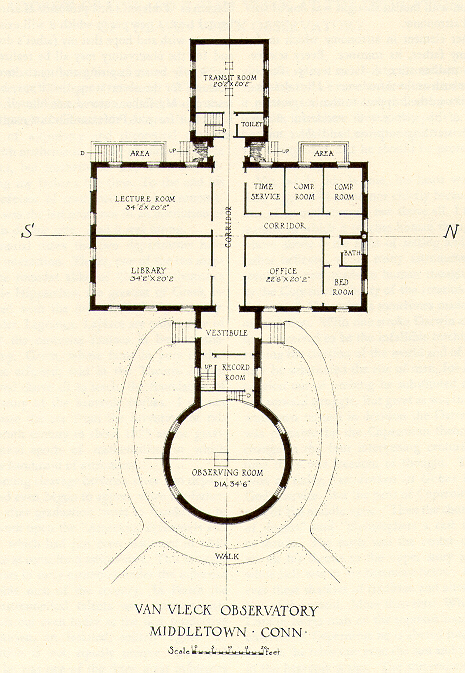 The new observatory was primarily designed with teaching in mind. Its principal instrument would be a 20-inch refractor with a focal length of 27.6 feet for demonstration and research. Dr. Frederick Slocum became the first Professor of Astronomy at Wesleyan and Director of the new Van Vleck Observatory when it was first opened for classwork and observations in the fall of 1915. The official dedication of the observatory was on June 16, 1916.
The new observatory was primarily designed with teaching in mind. Its principal instrument would be a 20-inch refractor with a focal length of 27.6 feet for demonstration and research. Dr. Frederick Slocum became the first Professor of Astronomy at Wesleyan and Director of the new Van Vleck Observatory when it was first opened for classwork and observations in the fall of 1915. The official dedication of the observatory was on June 16, 1916.
Alvan Clark Company ordered the glass for the lens of the 20-inch telescope from Schott & Company of Germany in July of 1914. The outbreak of World War I delayed the glass delivery. The order was renewed in 1920, and the glass was delivered later that year. The glass disks were 21 inches in diameter. Because of the very good quality out to the edges, the lens had a clear aperture of 20 inches instead of the originally planned 18.5 inches. "The lens was ground by Mr. C.A.R. Lundin of the Alvan Clark Company, and was installed in the Warner and Swasey mounting in July, 1922." The telescope saw "first light" that same year.
The 20-inch refractor has been used intensively over the years by Professors Frederick Slocum, Carl L. Stearns, Heinrich K. Eichhorn, and Arthur R. Upgren, assisted by Bancroft Sitterly, James Gibson, Ed Weis, and Roger Grossenbacher. Used sometimes as a teaching device, the telescope has been primarily a research tool taking star field images for stellar parallax measurements.
When Frederick Slocum was director of the observatory from 1914 to 1944, he brought back use of the old 6-inch telescope, most notably for two solar eclipses. For the solar eclipse of 1925, the 6-inch was mounted on the 20-inch along with several other instruments to take photos during the eclipse. A team of astronomers from Wesleyan traveled to Center Conway, New Hampshire for the 1932 solar eclipse. They hauled the 6-inch in the equipment along, but the use of the telescope was unsuccessful due to unstable mounting.
In 1959, the Trustees provided $20,700, with matching funds from the National Science Foundation, to establish a computing center for the use of the Astronomy, Chemistry, Economics, Math, and Russian departments. A Royal McBee LGP-30 electronic computer was installed in the basement of the Van Vleck Observatory on February 17, 1960. One of the first desk-sized computers, the LGP-30 had a 4096-word memory, where each word was 31 Bits (including a sign bit, totaling a little less than 16 kilobytes) and operated at a clock speed of 120 kHz.
1959 also saw the director Carl Stearns reinstate the 6-inch telescope for student use and remount in a new small dome on the west end of Van Vleck Observatory. In 1967, guided by Professor Art Upgren, the telescope was renovated. The old teakwood mounting was restored, and it was dedicated as the Wilbur Fisk Telescope on May 23, 1968. Dr. William Herbst retired the Fisk to its current display position in the main entrance of the observatory in 1986. Previously stored away in the basement, this telescope was now displayed in a place fitting of its historical importance.
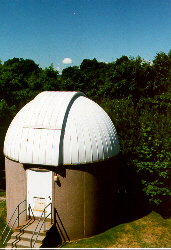
In 1971, Van Vleck Observatory acquired the 24-inch Perkin reflector, which is in the dome separate from the building on the west end. Manufactured for Mr. Richard S. Perkin in 1966 by Boller and Chivens, a subsidiary of the Perkin-Elmer Corporation, the Perkin family donated this telescope to Wesleyan. The Perkin Reflector has a primary mirror 24 inches in diameter and a focal length of 27 feet. Grants from the Perkin Fund, Research Corporation, and the National Science Foundation helped us automate and equip the telescope. A CCD detector for recording images digitally was obtained in 1991 through a grant from the W. M. Keck Foundation. The Perkin telescope is currently used for departmental research, including many senior and graduate student theses. Its primary use is for studying supernovae and variable stars, known as T Tauri stars, in a program directed by Professor Herbst, and exoplanet transits in a program directed by Professor Redfield.
We will fill in more details of our history as time permits, so stay tuned!
Sources
Much of the above was taken from the introductory sections of "Publications of the Van Vleck Observatory" Volume I, Stellar Parallaxes, and from a display in Van Vleck Observatory by Debra Herbst.
Some of the information about the Fisk Telescope was obtained from a pamphlet written by Thornton Page, Director of Van Vleck Observatory from 1960-1971, with special note: Most of the historical material for this article provided by John W. Spaeth, University Archivist.
Additional material by Roy Kilgard.
- 1916: George E. Hale - Pasadena, California
- 1921: Annie Jump Cannon - Cambridge, Massachusetts
- 1921: Harlow Shapley - Cambridge, Massachusetts
- 1924: Jan Oort - Leiden, Holland
- 1928: W. de Sitter - Leiden, Holland
- 1932: Edwin Hubble - Mt. Wilson Observatory
- 1936: S. Chandresekhar - Trinity College, Cambridge, England
- 1936: G.P. Kuiper - Harvard and McDonald observatories
- 1942: Cecilia Payne-Gaposchkin - Harvard College Observatory
Astronomy Resources
Tools
-
NASA Astrophysics Data System
-
Space Telescope Digitized Sky Survey
-
SkyView Virtual Observatory
-
U.S. Naval Observatory Time Service
-
SIMBAD on the Web
-
NASA/IPAC Extragalactic Database (NED)
-
American Astronomical Society Job Board
-
American Institute of Physics Job Board
-
Local Sidereal Time calculator
-
Hourly Airmass Table calculations
-
Astronomical Sky Calendar
-
Moon phase calculator
-
Planetary position calculator

Visit Us
Van Vleck Observatory
96 Foss Hill Dr.
Middletown, CT 06459
Events Information
Stef Dinneen
860-685-2130
astronomy@wesleyan.edu





